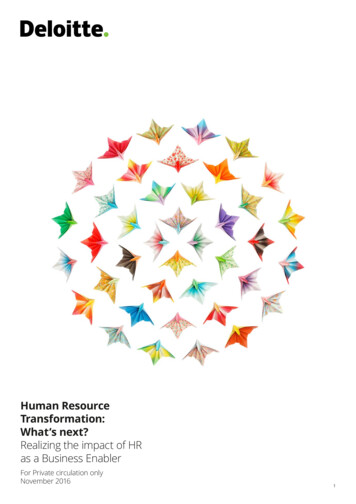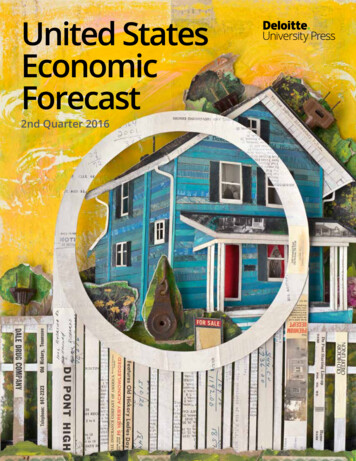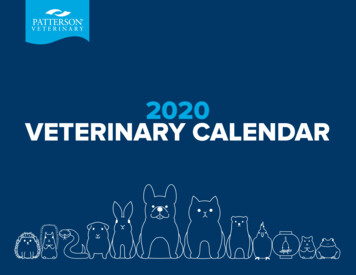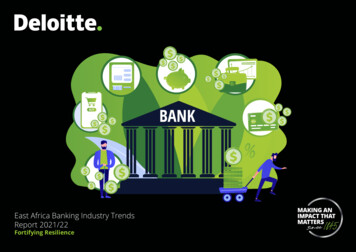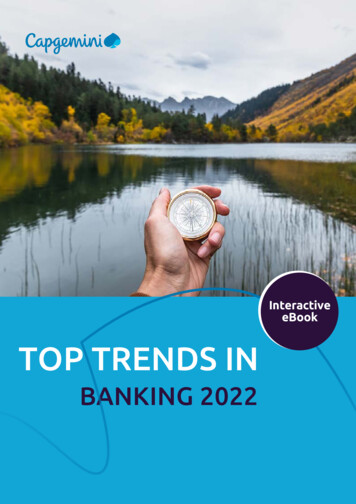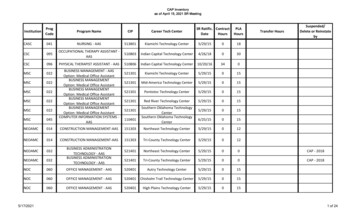
Transcription
TechTrends DeloitteTechTrends20222022 DeloitteInsights InsightsMutual acceleration: Humans technology propellingTechTrends2022each otherinto thefutureA humancapital perspectiveon Deloitte’s Tech Trends 2022LifeSciencesperspectiveThetechnologiesrapid shifts detailedin Deloitte’sTech Trends 2022aren’ttakingplace powerfulin a vacuum.Thethat enhanceour organizationsand ourlivesare more(and moreNor are theequallyshifts in the wayslifepeoplework.Because theunderstandwork humansessential)thanever dramaticbefore. Forward-thinkingsciencesorganizationsthedo and the capabilitiesso forcloselyit’s importanttechnologicalforces thattechnologysurround providesthem andarelookwaysrelated,to harnessthem fortothe benefitunderstandand accelerationas tionpatients alike.On the pagesthatfollow,we provide a life andsciences–specificmachines,each shapingthe other.year’sTech Trendsincludeimportantand rapidtakeon Deloitte’sTech chnologytrendsshiftslikelyin areassuch asthe ubiquitydata,newcloudarchitecture,the evolvingof may bemostto causedisruptionoverofthenext18–24months.We explorewhich roletrendsIT, andthe proliferationdigitaldevices—allof whichinteract incriticalwayswith the of them.mostrelevantas well as ofhowreadylife sciencesorganizationsareto takeadvantageworldtheof work.Fromrise of strategy and technology becoming inseparable to the rapidly disappearingboundary between the physical and virtual worlds, the trends we explore could haveprofound implications for business, life sciences, and society in the months and years ahead.
Mutual acceleration: Humans technology propelling each other into the futureThis document offers a special perspective on that interaction. Byviewing Tech Trends through a human capital lens, organizationscan better understand and prepare for the fundamental changes tocome. No matter how many technology investments an enterprisemakes, their full value can be realized only when humans drive thenecessary changes. Case by case, tool by tool, this is a moment toreconsider, re-engineer, and re-imagine.This is the reason we decided to focus on a selection of the 2022Tech Trends that feature mutual acceleration—technologydriving human capital change and vice versa, each fueling the otherand enabling the shift from traditional talent models to workforceecosystems: Data sharing made easy – organizations are deriving more valuefrom more data in more places. How does that change the natureof decision-making, and how do the resulting job changes andoperating models write a new role for technology? The cloud goes vertical – what happens when highly adaptableIT functions are intertwined throughout the business and ITchanges from being a connector to an operational and strategypartner? IT, disrupt thyself – today every employee is a tech person andevery tech person is wired into bottom-line goals. That meansteams are becoming flatter and long-held definitions no longerhold sway. The tech stack goes physical – “working from anywhere” isn’tjust for knowledge jobs anymore, and an organization’s digitaldomain includes physical assets from drones to monitors to robotsand the phone in each employee’s pocket. How are devices andwork defining each other?These trends and others add up to a workforce ecosystemwe haven’t seen before. In addition to internal talent, thisnew ecosystem encompasses gig workers, contractors, andecosystem partners—and it requires a new approach to talentand tech management. The assumptions people bring to it,and the operating models it fosters, have to keep pace.Workers in almost every role will have an opportunity to movetoward becoming “deskless”—not only knowledge workers whomeasure the day in keystrokes, but even factory workers who maybe able to monitor and manage physical machines from anywhere.Is this IT transforming people and their roles? Or is it a new worldof work shaping a future vision of IT? The distinction may no longerhold meaning. What’s important is that without human drive,technology can’t deliver the growth and efficiency it promises.Employers will face critical questions as they navigate thesetwinned channels of change. When technology and work moveahead in tandem, is every innovation an improvement? Whatif new technical capabilities serve only to automate inefficient2processes and lock them into place? Does having more apps atwork mean that work gets better? Are we prepared to let datadrive decisions? Can humans accept machines that are “smarter”than they are? Are humans ready to be strategic problem solversat scale? Are we able to manage the complexity of infinite systemsand workers outside of our internal organizational controls? Justbecause application development and technology infrastructurehave traditionally both lived in IT, does that mean they still should?Then there’s the well-worn concern about the boundaries betweenhuman and machine. It’s becoming more and more clear thattechnology is less likely to replace people than it is to elevate them—to bond in human-machine collaborations that take the best eachhas to offer, mutually accelerate each other along a shared trajectory,and create meaningful outcomes neither could achieve separately.As you explore the trends in this report, consider how each onecan shape your organization’s perspective on work and technology.Know the future will demand new standards for learning,expectations, and measurement, for both individuals and teams.There is more happening here than technology change—newecosystems are coming into being, shaped by the human complexitythat accompanies technical complexity. For every shift in the useof data, platforms, and AI, there are corresponding changes inareas like contracts, relationships, or federated management.Technology influences work, and work influences people.Don’t take any of today’s operating models for granted in a worldthat will see cloud and technology embedded in work insteadof adjacent to it. Be vigilant about the ways privacy and securitysafeguards may have to evolve to keep up with new practices andcapabilities. Audit and evaluate your current use of technologyto help establish a leaner, more meaningful starting point.It’s all happening fast, and speed offers both an attractionand a caution. As work and technology chase each other in amutually reinforcing pursuit of the new, they have the potentialto spiral ever higher together—or to fly off in incompatibledirections like children chasing a schoolyard tetherball. Whatcan determine the difference? Vision. Organizations witha comprehensive understanding of this moment are morelikely to embrace and unlock the value of technology promiseinstead of being buffeted by them. These glimpses ahead canhelp build that understanding and inspire plans for action.
Mutual acceleration: Humans technology propelling each other into the future The Trend: Data Sharing Made EasyThe Trend: Data SharingMade Easyhandling data, like data engineering, ingestion, and architecture.They also include enduring human capabilities like creativity,imagination, and a deep understanding of core business processes.To drive productive insights, all those components need to work inharmony.A host of new technologies promise to simplifythe mechanics of data-sharing across andbetween organizations while preserving theveil of privacy. As part of a growing trend,organizations are unlocking more value fromtheir own sensitive data while leveragingenormous volumes of externally sourced datathrough human machine interaction that hastraditionally been off limits. This can open up anew arena of data-driven opportunities. Indeed,the ability to share secured data with otherswithin an ecosystem or value chain is giving riseto new business models and products.An environment with more data-sharing is one that can benefitfrom an ecosystem mindset. People will feel less as if they’reaccessing data and more like they’re surrounded by it and can tapinto insights to inform their work seamlessly. Along with this datademocratization inside the organization, outside sources will alsoplay a role. There will be data you own and data you don’t. Becausefuture businesses will run on both proprietary and ecosystem data,outside sources will need to play a role in your decision-makingdirectly, without someone having to copy and re-enter it.Why human capital matters inyour data strategyData is a means to an end. Machines create and use data to makelogical and rule-based decisions, while humans contribute byreviewing insight-level data to make contextual and value-basedjudgments. Ideally, data can help an organization make fewerdecisions, and help people focus on significant ones.This approach can put machine and human development onparallel paths: more volume and complexity for the machines;more judgment and value-based and value-driving decision-makingfor the people. As part of this mutually reinforcing evolution, askilled workforce can unlock the value of data if it brings the rightskills to the job. Those skills include ones that relate directly to3That will take a fundamental shift in your trust model: You’ll haveto be willing to cede control. Data literacy and upskilling efforts canalso help your workforce become fluent in data ecosystems. Whenthey’re used to tapping into those resources, information andbusiness decisions can be more tightly integrated.What’s important is that through these changes, humans willhave access to information that previously felt unattainable.To connect those new dots and make decisions, humanswill first need to envision the art of the possible and thenaggregate data. None of this can happen unless people thinkacross company boundaries and resolve to be creative.Of course, when more data flows easily, concerns about privacy andsecurity follow. So do opportunities for misbehavior. Adding moredata can make a process feel more responsive and personalized,but that same use of data can also cross a line into makingpeople feel manipulated. For example, a team in a corporateenvironment might use data to make workforce decisions likehiring and firing even though they don’t have the decision rightsto do so under the company’s HR protocol. Or a retail customermay feel like a sales appeal is just a little too personal.
Mutual acceleration: Humans technology propelling each other into the future The Trend: Data Sharing Made EasyGuarding against effects like that calls for tight data governanceand data management processes along with data validation andaudits. This may create entirely new roles in the ecosystem todrive the necessary checks and balances. From a human capitalperspective, that means education on secure and ethical behaviorsshould develop alongside technical skills.Case in pointAlmost every organization is experiencing this acceleration of dataflows in some way. For example, one large pharmaceutical companyfound that the increase in its data flows, or data democratization,was a large part of the value proposition for moving its data to thecloud. At different scales, this change applies across industries.Today, smaller organizations are moving to incorporate principlesof sound data management that were once the province of larger,more complex enterprises. All of this activity requires new skills anda broader understanding of how to unlock the value of increasedaccess to data, as well as the creative space necessary to uncovernew insights buried in the flows.So instead of concreteplans, have a vision, forecastthe needs that are likelyto emerge, and be readyfor anything.4Getting startedEmbracing the new data-rich environment will involve both discreteskills and larger cultural shifts. Large parts of the workforce, includingthose not traditionally tied to IT, will need more data literacy andproficiency in the tools that handle it. But entire organizations willalso need to develop data-first cultures that are comfortable withdata aggregation, mining, and analysis—most of it automated—asthe foundations of decision-making.A good focal point for automation can be on lower-level decisionsthat require less human judgment and which may otherwise featureas distractions in a person’s workday. That can provide a doublebenefit, as the technology is put to work in reliable, repeatable waysand the human workforce can run with the output by making higherlevel, value-added decisions.Organizations that want to take advantage of freer-flowing datashould also focus on action. It’s possible to have new informationsources and derive new insights from them, and still remainparalyzed when it comes to making tangible changes as a result.To move past that block, focus on making micro-decisions, embeddata-driven confidence into your organization’s culture, and beconscious about pairing data with human experience and judgment.The benefits are out there. What will do you to help your workforceunlock the power of data?
Mutual acceleration: Humans technology propelling each other into the future The Trend: The cloud goes verticalThe Trend: The cloudgoes verticalThe center of gravity around digitaltransformation has shifted from meeting the ITneeds of an industry-agnostic organization tomeeting the unique strategic and operationalneeds of each sector and even subsector.Hyperscalers and SaaS vendors are working withglobal system integrators and clients to providemodularized, vertical-specific business servicesand accelerators that can be easily adopted andbuilt upon for unique differentiation. As thistrend gains momentum, deploying applicationswill become a process of assembly rather thancreation—a shift that could reorder the entirevalue stack. Business processes will becomestrategic commodities to be purchased, freeingorganizations to focus precious developmentresources on critical areas of strategy andcompetitive differentiation.Why human capital matters inyour tech strategyCloud technology is changing the way work is done across thetechnology function and the business. People within what used to becalled IT are partnering with the rest of their organization in differentways, people across the spectrum of job families are being upskilledand reskilled to cloud functions. People in areas like software5engineering, architecture, infrastructure, security, and risk need tobe onboarded to new platforms, capabilities, features, and functions.They need to understand the ways these changes affect the waysapps are managed and how work gets provisioned. It’s important tounderstand what legacy skills each team brings to this evolution soteams and individuals can be targeted with the training they needand the learning pathways that will carry them forward. Applicationteams are working in environments that require new cloud-nativeskills, with heightened expectations for speed to value. Theemergence of vertical and industry clouds is changing the alignmentof operating models as well, with implications for human capital:When cloud work is embedded in the product team, the result is aproduct operating model and a move to “thin tech” with more directexposure to the business and its opportunities.Historically, technology has been a value add and connector, anda focal point through which all data had to flow. But today—wheneach part of the business has its own function-adjacent cloudcomponents and control of its own data—technology must find newways to add value.What’s the way forward? If the demands of work change technology,technology changes work in turn. The competition for talent shifts,reliance on hyperscalers to provide platforms as a service (PaaS)may grow, and technology has a greater exposure to the businessand a greater ability to frame how work evolves. That’s because techis no longer just a value-adding point that data flows through. Formany organizations, tech is the business, at the core of your abilityto deliver products and services, enable new working styles, andinnovate. Today’s technologists need to understand business goalsand outcomes—and where this represents a change, it’s one that hasto happen quickly for the organization to win.To achieve cloud ambitions, some new skills and capabilities willgain importance as others wane. Organizations should architecttheir cloud strategies with skills at the center, to position themselvesfor flexibility in hiring, alignment, and rewards. As cloud readinessbecomes more important throughout the organization, those thatcan adapt and adopt talent changes the fastest will win the day. Morepeople in more roles will need to be adept at handling structured
Mutual acceleration: Humans technology propelling each other into the future The Trend: The cloud goes verticaland unstructured data. And compensation may no longer be themost powerful driver to achieve these changes, because today’sstakeholders demand transparency from leadership and evenexcitement from their work instead. The list of relevant roles andskills may be very different a short time from now:Shifts in the IT workforceIllustrative RolesJobs that changeJobs that disappearJobs that are newEnterprise ArchitectRelease ManagerCloudOrchestrationIT FinanceTestingProductDevelopmentHR BusinessPartnerServices Managers /HelpdeskData ScientistsTestingOrchestrationTech ArchitectureData Analysts/InsightsSystem & NetworkAdminsHuman CenteredDesignPortfolio ManagersOpen TalentOrchestrationBusinessArchitectureVirtual RealityDesignerProject ManagersBusiness /Functional Analysts6It’s likely organizations that turn to vertical clouds will outsourcemore technology resources but keep functional teams in-house.Because people will have more resources at their fingertips, theremay be lower barriers to innovation and new product creation inspaces like this.Case in pointIn its quest to turn the cloud into a catalyst for broad businesstransformation, one major financial services organizationimplemented a technology skills taxonomy that was matched toits current and future needs. The goal was to transition to a skillsbased talent strategy instead of a function-based one—which notonly served the company better in infusing technology across thebusiness, but also helped it differentiate in a competitive technologytalent market.Getting startedMany organizations are amassing useful experience with verticalclouds. The more effective ones are those who bring as muchorganizational agility to the operating model and workforceimplications as they do to the technology ones. Boundaries withinthe technology function, or between it and the business, are lessimportant now than a product operating model that puts decisionscloser to where the work happens.For those embarking on the journey to vertical clouds, it’s importantto have an honest assessment of how ready you are to move atspeed; how you can align people, performance, and managementtendencies to embrace the new capabilities; and what metrics cancapture this new pace of performance and innovation.
Mutual acceleration: Humans technology propelling each other into the future The Trend: IT, disrupt thyselfThe Trend:IT, disrupt thyselfFaced with creeping technological complexity andhigher expectations of stability and availability,some CIOs are radically reengineering their ITorganizations. How? By taking a page from thecloud provider’s playbook. They are identifyingrepetitive, manual processes and applyinga combination of engineering, automation,and self-service. The net result is streamlinedtimelines, accelerated value delivery, and moreeffective and stable IT across the board. Thiskind of disruptive automation represents avast yet underrealized opportunity. Previoustechnology trends such as NoOps, Zero trust,and DevSecOps share a common theme—the importance of moving to code across theorganization. Migrating away from manualadministration to engineering and automation,organizations can manage complex systems moreeffectively and improve the customer experiencethrough improved availability and resilience.Why human capital matters inyour tech strategyFor most of history, humans drove innovation, some of whichtook the form of technology. Now, technology helps humansdrive innovation. In a “no ops” model that flattens IT from adomain of its own to a hierarchy of expertise areas, IT is nowdistributed throughout the business—where everyone is onthe same team, working towards the same goals, measuredby the same metrics. Self-service and automation willhandle more of the daily work, including but not limited totechnology work, changing the fundamental nature of rolesrequired within IT. As part of that evolution, IT specialistsshift from service providers to strategic advisors who helpnegotiate the more frequent touchpoints between work andtech. This altered role is becoming more important, becausetoday every part of the organization requires technology tobe part of its solutions, strategies, and ways of working.If everyone in an organization must be tech-savvy, what becomesof IT and its former role? Work may require IT professionals tospeak and act differently. They can still specialize, but as developersthey’re now more likely to share ownership of a product or projectwith people in the business units. For example, instead of lookingfor SAP developers, you may look for people who can attack agiven need or problem in a multidisciplinary way. As the partnerand supplier network grows more complex, you may need peoplewho can navigate, negotiate, and motivate people to get both thetechnology results and the business outputs. Managing theseteams is more art and experience than science. That will place anemphasis on teamwork, and for human capital, the ability to curateteams effectively. Where infrastructure and on-premises datamanagement skills have long been predominant, analytical skillsand the insights they drive will grow more important—as will theability to put those insights into operation.While any large-scale shift presents challenges to a workforce,the rise in IT automation also delivers advantages. With data andanalytics functions intertwined with business functions, managers7
Mutual acceleration: Humans technology propelling each other into the future The Trend: IT, disrupt thyselfcan expect to have better information at hand for predictions anddecision-making, with less dependency on legacy architecture andfewer transactional attests.At the same time, engineers are developing solutions that supportactive and regular integration, regular releases, and systems thatare resilient – that is, designed not to break, or to identify the breakpoints when they do break. That shift may change, reduce, or eveneliminate the roles of some people whose current jobs focus onbreaks and fixes. Another downstream shift from automation is thatquality engineering becomes a cultural attribute. Think of it the waydangerous jobs and industries think of safety—as an ethic, not justa process. Automation can also foster the expectation that IT mustunderstand business and operations as well as or better than thepeople that are performing those roles in the business today. If ITlives up to that expectation, it can bring solutions that the businesshas not even thought of.As these changes accelerate, providing rewarding collaborativeexperiences will offer the engagement that discourages skilled talentto jump from job to job. A rise in business partnership, contactwith more colleagues, and the need for overlapping skillsets hasthe potential to improve efficiency, simplify work, and redefinecollaboration. Today everyone is a tech worker, and your techiestpeople aren’t necessarily the ones who report to IT.Case in pointThe move toward IT automation and decentralization is havingeffects in the consumer arena, where shifts are adding to the agilityof front-line store personnel, while store operations benefit frommore insight into building and utility costs and manufacturers usenew analytics to improve speed to market.In health care, driving IT capabilities into the broader workforce isallowing front-line workers to address both regular clinical needs andCOVID-specific needs even with smaller headcounts. Human capitalorganizations in these settings have more flexible tools to enhancetheir strategy, planning, and scheduling, and can make moreinformed decisions on hiring.Airline and travel organizations are benefiting as well in areas likemaintenance and engineering, where a new, flatter interaction modelbrings IT when and where it’s needed. These organizations are usingdata more precisely to inform where and when they need to deploytheir workforces.8Additionally, a major enterprise cloud computing companyexperienced these shifts in the ways its clients used its platform. Itwas originally offered for IT service management, but clients startedusing it for cybersecurity, HR, and other needs—illustrating the waysdifferent parts of the business are moving to own their adjacent ITfunctions. The cloud company has attempted to answer that demandwith more machine learning-enabled automation and roboticprocess automation capabilities. And everything the companydebuts, it tests internally first.Getting startedTo derive the potential value of automated and self-service IT,many organizations may need to do more to bring learning anddevelopment resources to their new tech talent ecosystems. Incontrast to traditional training, defined as time away from work,people can grow capabilities incrementally without productivityloss if they work and learn together as they go. Leadership can playa role not only by encouraging this new avenue of professionaldevelopment, but also by modeling the learning process themselves.Practices like that can help foster purposeful growth, careerplanning, and experiential learning that expands well beyond theboundaries of IT.Think of teams in a flatter way: Instead of assembling people forthe specific skills each one brings to the table, organizations canfoster an environment in which all members of a team have the skillsand attributes the whole team needs, and share the collaborativeexperiences that bring those skills to their full potential.Parse the DevOps conversation in your organization with an eyetoward using human resources effectively. Who will gain skills duringthis evolution? Who needs to? Technology capabilities are only partof the mix: people will need more rounded skillsets in teamwork,collaboration, strategy, human connections, and the agility to workacross domains. On the other hand, people from the business sidewill need to become more tech-savvy in an environment where theytouch technology more often and more meaningfully.
Mutual acceleration: Humans technology propelling each other into the future The Trend: The tech stack goes physicalThe Trend: The tech stackgoes physicalWith the explosion of “smart devices” andthe increased automation of physical tasks,IT’s remit is growing again, extending beyondlaptops and phones. CIOs must now considerhow to onboard, manage, maintain, and securesuch business-critical physical assets as smartfactory equipment, automated cooking robots,inspection drones, health monitors, and countlessothers. Because outages could be businessor life-threatening, devices in the evolvingphysical tech stack require the highest levelsof system uptime and resilience. And a freshapproach to device governance and oversightmay be needed to help IT manage unfamiliarstandards, regulatory bodies, and liability andethics concerns. Finally, CIOs likely will need toconsider how to procure needed technologytalent and reskill the current workforce.Why human capital matters inyour tech strategyWhen technology manifests physically, it has the potentialto take away even more of the “three Ds” – work that’s dirty,dull, or dangerous – leaving humans more time for higherlevel thinking and strategy, even as there are fewer humansprepared to do so. That can be true even in workplaceswhere that may seem far-fetched—“work from anywhere” is9no longer just for knowledge jobs. Think of factory workerswho can run production machines remotely, or the potentialtransformation of the trucking industry given drone delivery.Workers in almost every role will have an opportunity to movetoward becoming “deskless”—not only knowledge workers whomeasure the day in keystrokes, but even factory workers who maybe able to monitor and manage physical machines from anywhere.Is this IT transforming people and their roles? Or is it a new world ofwork shaping a future vision of IT? The distinction may no longer holdmeaning. What’s important is that without human drive, technologycan’t deliver the growth and efficiency it promises.That change can drive operational value because machines areresilient, less error-prone, and don’t need to rest. But it can alsodrive human value, by promoting more effective human-to-humaninteraction and helping people derive insights and make judgments.If people work alongside a network of supportable mini-machines,the result could also be a boost in productivity and connection:Letting humans be human is the foundation of community-building.This can happen when organizations match technology investmentswith equal attention to human-centric and quality improvementconsiderations. It takes comprehensive thinking to manage, support,and coexist with more pervasive technology, and to make thoseadjustments sustainable.There are also potential downsides to a greater reliance on physicaltechnology. Outages or malfunctions can disrupt business or evenpose physical dangers to people. For that reason, resilience andsystem uptime have to be a priority. It’s also important to managetechnology systems in a way that upholds trust and roots out bias.The more an organization and its stakeholders rely on smart devicesand connected dependency, the greater the potential impact ofbiases that may be hard-coded into those systems.Managing human capital in that environment can call
The rapid shifts detailed in Deloitte's Tech Trends 2022 aren't taking place in a vacuum. Nor are the equally dramatic shifts in the ways people work. Because the work humans . drive the necessary checks and balances. From a human capital perspective, that means education on secure and ethical behaviors should develop alongside technical .

